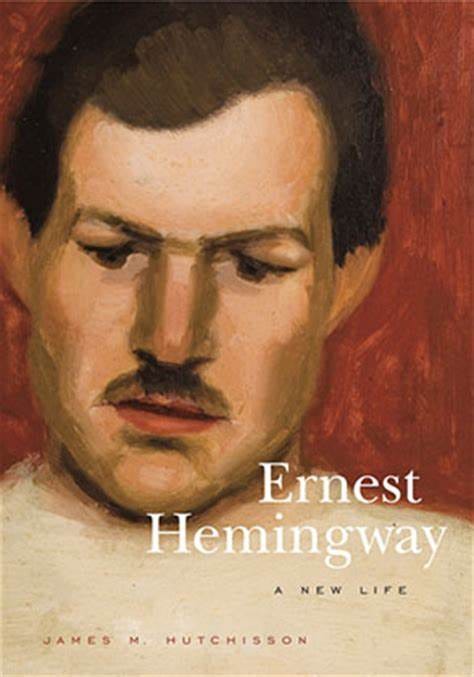Hutchisson, James M. Ernest Hemingway: A New Life. University Park, PA: Pennsylvania State UP, 2016.
On both the scholarly and popular levels, Carlos Baker’s 1967 Ernest Hemingway: A Life Story and Michael S. Reynolds’s five-volume biography published between 1986 and 1999 have tended to dominate the landscape of studying Hemingway’s life. Falling in between them, and beyond, lie a smattering of specialist approaches. Many of these biographies either explore the roman a clef motif in Hemingway’s writings, such as Lesley M. M. Blume’s Everybody Behaves Badly, or opts to focus on a pivotal moment in Hemingway’s life, like Amanda Vaill’s Hotel Florida. The work of Baker and Reynolds laid the foundation, and new structures continue to be erected upon it.
James Hutchisson’s contribution to the field of Hemingway studies not only adds to that structure but goes a step further by redesigning adjacent areas. Ernest Hemingway: A New Life is the first biography in two decades that offers more than a snapshot of the iconic American author. Though it does not purport to be a full account, Hutchisson covers the whole scope of Hemingway’s life, trying to present Hemingway as neither “tragic nor heroic” but to present “a balanced assessment that shows the ambitions that drove him, and the anxieties . . . that destroyed him” (4). It is a focused-broad approach, spanning the scope of his life while concentrating on only a few elements of Hemingway’s life and work.
The book is broken up along the creative periods in Hemingway’s life, and thus examines the places and people who surrounded the author at those times. Hemingway’s stint in Chicago puts him into contact with “the next serious love of his life, Elizabeth Hadley Richardson” (42). His life in Key West bounces between his second wife, Pauline, and other women such as Jane Mason and Martha Gellhorn (125, 142). This fits with Hutchisson’s idea that the contours of Hemingway’s writing followed unique patterns in terms of his locations and his relationships. The thrust of A New Life is that the landscapes surrounding Hemingway, both the physical and the emotional, played an oft overlooked part in the development of his publications. The
One of the highlights of this approach is the prominence given to figures who have previously been mere background figures. For instance, Sara Murphy had been known for her role in introducing Hemingway to Hadley Richardson, but Hutchisson presents her as “a sympathetic sounding board for [Hemingway’s] emotional lows” as well (57). Likewise, moments of Hemingway’s life where he finds himself in odd locations, like a Chinese military academy, are put on display alongside the more famous and well-known locales such as Key West or Ketchum (180). Hutchisson’s interest in the milieu of Hemingway’s life shows just how varied Hemingway’s experiences were, as well as the sensitive reactions he often had to the upheavals that marked his life. Rather than a larger-than-life caricature, Hutchisson presents a real person, someone you might meet on the airplane or bump into while walking downtown. This is the real strength of A New Life, and it serves as a helpful reminder that the icon lived and moved and breathed like everyone else.
While this compassionate picture is to be commended, there are moments to be skeptical of in the biography. Hutchisson might outline the contours of Hemingway’s life by “following the “pattern of how his writing was influenced by women and by place,” but it is typically the former which prevails throughout the narrative (3). The locales and landmarks exert less influence than the women who populate them, and Hemingway’s obsessive features play prominently as a result. For instance, in his telling of Hemingway’s time in Italy, where Across the River and Into the Trees took shape, the creative outburst is presented as though it were solely the result of the attention he received from Adriana Ivancich (208-209). It makes sense that individuals might serve as a muse to Hemingway’s art, but Hutchisson’s picture suggests that the muses were the only way Hemingway ever found inspiration. After reading A New Life, it would be hard to imagine The Sun Also Rises as anything other than veiled autobiography, which is to return to old haunts rather than to break new ground.
Hutchisson tends to, thus, concentrate on aspects of Hemingway’s character such as his perceived insecurity and avoidance of loneliness (85). He writes as if it is strange that an individual would make friends when moving to a new place or seek the company of like-minded people when going to a bullfight or hunting trip (185). This perspective tilts the events presented in Hutchisson’s favor, for as much as Hemingway changed locations and lovers, it does not prove hard to align those moments with specific points of creativity. While this makes for an interesting view, it is not entirely persuasive.
Hutchisson’s prose is casual, giving the reader a sense of overhearing a delightful story or watching a well-narrated biopic. The portrait of Hemingway that Hutchisson creates is a sympathetic one. Hemingway is just a man after all, and he happens to be one who is tied emotionally to the land the loves and easily swayed by women who loved him. While the idea of a writer’s work taking shape under the circumstances of their life is not new, it is dangerous to trace quality or quantity in relation to Hemingway’s writing. The Sun Also Rises came to life amid Hemingway’s anguish over choosing between Hadley and Pauline (84-85), while To Have and Have Not stumbled into the light during the Jane Mason controversy (127). Hemingway’s successes and failures seem to stem equally from tensions and times of peace. Just as Hutchisson reminds readers that there was far more to Hemingway’s life than his exotic adventures or turbulent marriages, it is necessary to keep in mind that the artist invents from what he knows (DIA, 192). And if he has crafted his art well, it will be as if he had lived it.





